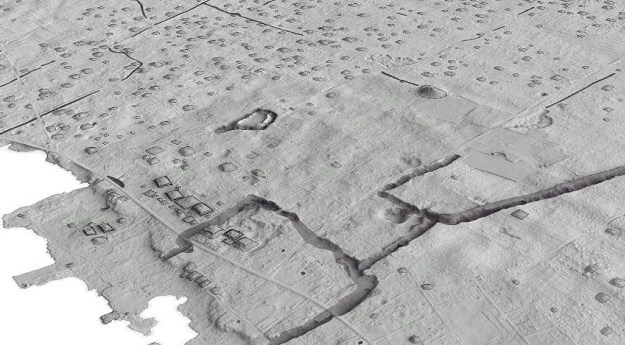ED GARVIN
The rapid growth of interest in such websites as Google Earth and Virtual Earth has been an overall benefit to the spatial industry. However, there has been much discussion regarding the use of the spatial information from these websites. It is centred around the value that they add, the value that they imply and how they will impact on the future value of spatial information generally. It is timely to examine this aspect of our industry more closely because it is the key to our future success.
While the nomenclature may be recent, value chains are not a new business phenomenon. The idea of creating value has been with us since time immemorial. Otherwise why would we wish to barter, buy or deal with others in commercial, administrative or everyday circumstances?
One party has something that the other party values and a transaction occurs. The value could be created from the needs of human existence or a desire for improvement, and is inherently in the perception of the parties involved. A series of transactions becomes a value chain; at each transaction, value is increased or the chain stops. While it can be argued that spatial information is at the very foundation of numerous value chains, it also has its own value chain.
Take the example of a land transaction. A purchaser wishes to own some land and a vendor wishes to sell it, so a transaction takes place. Sounds simple? Most readers of this journal would know otherwise. Things are rarely what they seem on first sight (although unfortunately, this prevailing perception is the bane of our industry).
In reality, a vendor makes a decision to sell, approaches an agent who promotes the sale and engages a conveyancer to prepare a contract. A purchaser views the property, commits to buy, engages a conveyancer to review the contract and approaches an organisation for finance. A surveyor is engaged to prepare a survey, inspections are undertaken by experts and searches are made through state, local, utility and land title authorities for building condition, rates, impediments and charges. After all documents and monies are signed, exchanged, delivered and registered with the land titles authority, the new and old owners or occupiers engage removalists.
At each step, someone is adding value to the process. If it were otherwise, why would any of these people be involved? For a new parcel of land, the value chain is even longer. Each provides a service or product that adds value to the process. Figure 1 shows the rudimentary value chain that demonstrates this process.
In both cases, the processes are underpinned by basic spatial information. The spatial information would be useless without the systems and delivery mechanisms that allow its analysis and wide use.
The history of value chains of spatial information (including cadastral information) and its distribution in Australia has always been driven by the public sector and, generally, public need. This applies to all spatial data – whether for defence, infrastructure, administration or other purposes. More recently, the process has been characterised by a slow handing over of functions from the public to the private sector.
Government officers undertook land grants, as well as mapping the early colony. Then, as government resources became scarce and private development grew, more work passed to the private sector. Policy, controls and standards were still set by the public sector.
For instance, the Torrens land titling system is a policy of state guarantee of ownership. It requires underpinning by sound survey of land parcels in a requisite form (standards) and acceptance by a land titles authority (control).
The co-ordinated mapping of Australia largely grew out of defence needs after World War II, but it also satisfied research, primary industry and the development requirements of both public and private sectors. However, the work was undertaken by the public sector at federal and provincial level.
This fed a growth of mapping infrastructure by the public sector that largely still exists today. What would have happened if more contractors from the Australian private sector had been involved in the mapping program? Would our industry be broader and stronger and better prepared for export markets and investment in new technology?
We do have a healthy private sector in the industry, but we are also facing increasing competition from our neighbours in SE Asia. But would it not be healthier still if we had a stronger private sector? That way the public sector could set policy, standards and controls when required, and remain robust with a strong private sector.
There are many examples of the public sector withdrawing from some activity, and the private sector successfully taking over. In other cases, where the public sector has been privatised, business has become more efficient, output has improved and innovation enhanced.
A great example is PSMA Australia Ltd, which is a public company wholly owned by state and territory government agencies. PSMA has also been streamlined using an outsourcing business model.
Google, Yahoo and Microsoft use a business model for spatial information delivery that is similar to free-to-air television. The cost to users is – or I believe it will be – the inescapable requirement to view advertising whenever the website is accessed. Google also gets revenue from regular visitors who need information or access to code for embedding or enhancing their own websites. Sensis’ WhereIs has also used this business model for years.
This is one example of business model used by the private sector, but there are many others. Each has a different value chain, but all are sustainable and enduring. In fact, much of the information that is provided by these organisations can be obtained from many other public websites.
There is always going to be a public needs argument – based on the service delivery required to maintain our way of life and a civilised society. However, there needs to be careful analysis of at least two decisive factors.
The first should be: how can the service be delivered most efficiently and effectively? This does not always mean that it should be undertaken by the public sector. A good example is the outsourced model used by the Australian Government for delivery of social services.
Nor does it necessarily mean that the private sector is better. Issues of probity, privacy and security must be considered, and the motivation of the private sector to realise a return on investment could inhibit take-up of outsourcing offers.
The second follows from the first. Will society as a whole benefit from keeping functions generally within the public sector? The economy as a whole must be considered. Our capitalist society involves the taxation of businesses and the individuals employed by them to fund those activities required by society. It is a complex and interwoven economic structure but one thing is clear – the more income that business generates, the more taxes are collected so that, in turn, we can afford the services supplied by government that make us a civilised and caring society.
There is also a benefit to the public sector in outsourcing or devolving services to the private sector. The effects of the vagaries of government funding and policies, and demand for public services – as all who have experienced programs that have waxed and waned well know – can be mitigated by having other organisations undertake the work.
The private sector is better placed to be able to spread work from various sources and maintain viability, while public sector organisations are often more focused and structured for single function service provision.
In any case, other things being equal, if the public sector is concentrating on setting policy and standards for programs, it can be more responsive to changes in government requirements. It is then able to control delivery through the private sector.
It can also be argued that there is little incentive for public sector organisations to provide added value when they are constrained by rigid terms of reference in their enabling legislation. This legal environment deprives them of any motivation to undertake innovation or to increase value.
The same restrictions do not apply to business. The profit motive encourages businesses to take advantage of the intellectual property in information, processes and technology.
The disadvantage of this, is that unless there is the possibility of profit, the private sector will not undertake value adding in the public interest. The increasing adoption of triple bottom line reporting by private organisations will assist to overcome this issue.
Generally speaking, small-tomedium enterprises have not been as profit focussed as larger and public companies in that there is often a contribution to community and the public benefit.
So how we can best achieve the balance of supplying the spatial information services that society requires to be civilised, and promoting business to afford them? We first need a careful analysis of spatial industry value chains. It should not simply be an argument that because a public service is required, it should be undertaken by the public sector.
There should also be careful consideration of how governments create and sustain capability. For instance, Canada has created and sustained a vibrant and multinational spatial industry through the GeoConnections program. At the same time, the government maintains control and still provides public services and the internal structures required to support them.
Government grants and investment have seen many new businesses born and matured through the program. These businesses are now deriving export income from the technology and services created under the program.
I believe that it is time for the Australian industry to review its structure and business models. We need to promote a healthy private sector, whilst simultaneously sustaining public services. If we are to maintain not only our leadership of the industry but also our sovereignty of it, the Australian spatial industry must be able to compete locally, regionally and internationally.
Better collaboration between private and public sectors in the spatial industry will lead to better understanding of the needs of both. It will also create a healthier relationship in which all parties can benefit. This should be our industry’s goal, rather than the current climate of often indiscriminate and ill advised decision making and suspicion between the two sectors.
It will not be a quick – nor necessarily an easy – solution but I get the feeling that there is the will to make things better for all concerned. But to achieve it, we need to understand the value chains. Bring it on!
Ed Garvin is managing director of Omnilink and a partner of Garvin Morgan & Co. He is also on the board of ASIBA, the chair of Consulting Surveyors NSW and a part-time lecturer at UNSW. The views in this article are the author’s own, based on further education and observation throughout a 38-year career in both sectors of the industry. They are not associated with any other organisation.
Issue 32; December 2007 – January 2008













